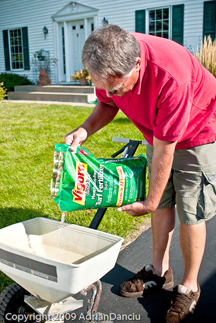Green Up Your Lawn, Not Your Lakes and Rivers

Fall is right around the corner and, for many home and business owners, this means a final blast of fertilizer on the lawn to ensure thick green grass in the springtime. However, your fertilizer may end up somewhere else besides your lawn – our waterways. In Rochester, we all have waterfront property because ditches and storm sewers transport storm water and pollution from our property to our lakes and rivers. So, whatever we do to our lawns can affect our water. Residents should use responsible fertilizing practices this fall as a way to help protect water quality.
What’s the Big Deal About Phosphorous?
Phosphorous is one key ingredient in Nitrogen-Phosphorous-Potassium (N-P-K) fertilizers. Excess phosphorous can lead to accelerated algae and weed growth, decreased oxygen levels, and increased water temperatures. Waterways can develop a green, smelly scum and aquatic creatures can suffer as a result. It is illegal to apply fertilizers containing phosphorous to lawns in Minnesota unless the following conditions exist:
- A new lawn is being established by seeding or laying sod
- Soil testing shows a phosphorus deficiency
- Fertilizer is being applied to a golf course by trained staff
Doesn’t My Lawn Need Phosphorous?
Soils in most parts of Minnesota already have an adequate amount of phosphorous to grow a healthy lawn, so you probably don’t need it. Nitrogen, not phosphorous, greens up grass. Phosphorous-free lawn fertilizer still contains nitrogen. If you are concerned that your lawn may need phosphorous, have your soil tested through the University of MN Soil Testing Lab (www.oiltest.cfans.umn.edu).
Responsible Fertilizing Practices
Commercial fertilizing companies typically do not use phosphorous (unless your soil test determines that you need it). If you are a do-it-yourselfer, look for the middle number when you buy fertilizer! A string of three numbers on a fertilizer bag shows its chemical content – the middle number shows the phosphate (phosphorous) content. A zero in the middle means phosphorous-free fertilizer. Apply fertilizers at the recommended rate, and never before a storm. Avoid getting fertilizers on natural drainage areas and hard surfaces. NEVER wash off fertilizer spills into the street. Instead, sweep up spills and excess granules.
Submitted by Megan Duffey, Storm Water Educator, City of Rochester Public Works Department
Have a comment? Join us on Facebook!